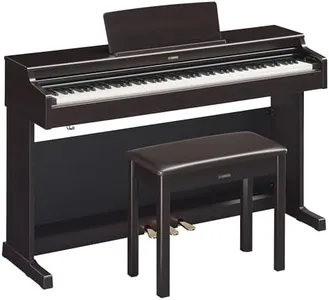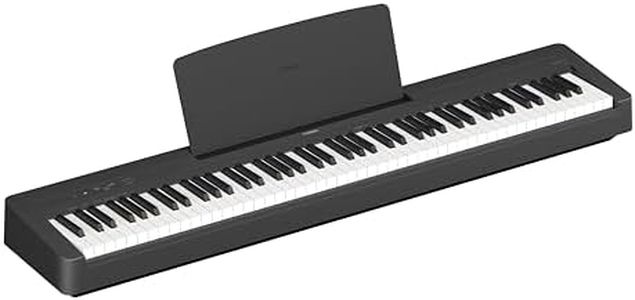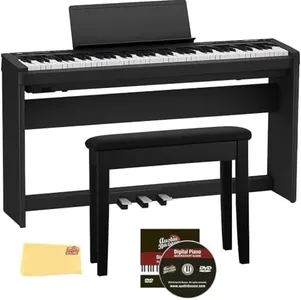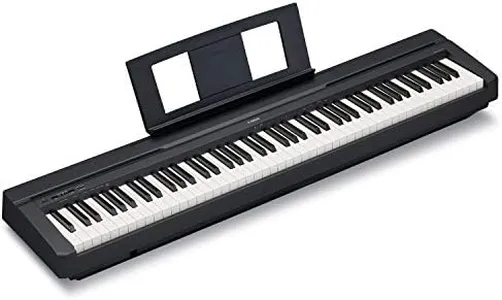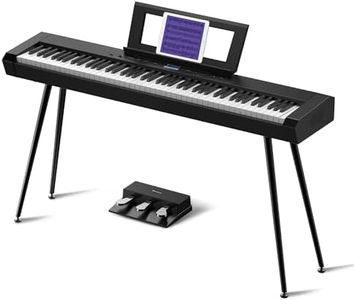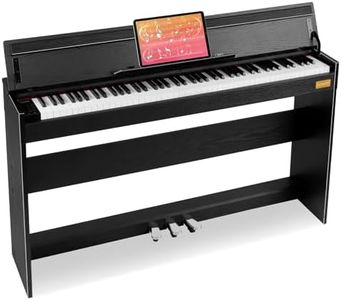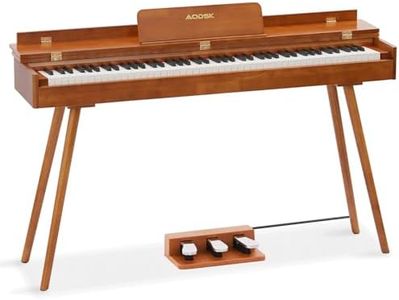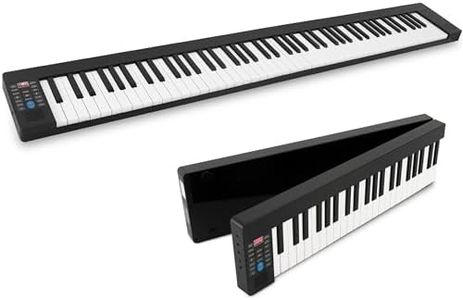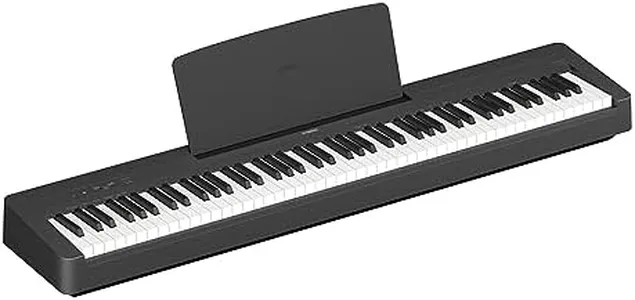10 Best Weighted Keyboards 2025 in the United States
Our technology thoroughly searches through the online shopping world, reviewing hundreds of sites. We then process and analyze this information, updating in real-time to bring you the latest top-rated products. This way, you always get the best and most current options available.

Our Top Picks
Winner
Yamaha Arius Series 88-Key Digital Piano, Weighted Graded Hammer 3 Action (GH3), CFX Concert Grand Piano Sound, Includes Bench, Dark Rosewood YDP165R
Most important from
655 reviews
The Yamaha Arius YDP165R is a solid choice for anyone in the market for a weighted digital piano, particularly those who value a realistic playing experience. With its 88 graded hammer keys, it replicates the feel of an acoustic piano, making it suitable for beginners and experienced players alike. The synthetic ivory tops on the keys enhance grip and comfort, which is particularly beneficial during long practice sessions.
One of the standout features is the CFX Concert Grand Piano sound, delivered through advanced VRM Lite technology, ensuring a rich and authentic audio experience. The built-in speakers provide powerful sound, complemented by three piano-style pedals that enable nuanced performance. For those who enjoy learning, the variety of built-in songs and compatibility with the Smart Pianist app offer great educational value.
On the connectivity front, the YDP165R includes Bluetooth, Wi-Fi, and USB options, allowing for easy integration with other devices and apps, which can enhance your playing or recording experience. The piano is quite heavy at 92.6 pounds, making it less portable if you intend to move it frequently. The price point may also be on the higher side for casual players or those just starting. Additionally, while the built-in sounds are impressive, some users might eventually desire a broader range of tones for different musical styles.
Most important from
655 reviews
Yamaha 88-Key Digital Piano with Weighted Keys, Compact Design, Bluetooth, Keyboard, Music Rest, Sustain Foot Switch, and Built-in Speakers for Home Practice or Travel P145BT
Most important from
1961 reviews
The Yamaha P145BT is a well-rounded 88-key digital piano that brings the feel of a real acoustic piano right to your home or on the go. Thanks to its weighted keys with Graded Hammer Compact action, it offers a natural touch that mimics the resistance and response of traditional piano keys—great for beginners and more advanced players alike. The sound quality stands out with a rich, full tone that captures the essence of a grand piano’s resonance, helping you enjoy a satisfying playing experience.
Its compact and lightweight design makes it easy to move around, which is ideal if you want to practice in different rooms or even take it with you while traveling. Built-in speakers provide clear sound without needing extra equipment, and the inclusion of a sustain foot switch adds to the authentic piano feel. One handy feature is the Bluetooth connectivity that lets you stream music wirelessly and play along with your favorite songs, enhancing practice sessions and making learning more fun. The piano also supports useful apps for practice and recording, making it a modern, user-friendly instrument.
Customer reviews are excellent, highlighting satisfaction with the instrument. However, the P145BT does not specify polyphony (the number of notes it can play simultaneously), which could be important if you plan on playing complex pieces or layering sounds extensively. Additionally, there are no built-in rhythms or extensive sound banks, which might limit variety compared to some keyboards. For those seeking an authentic piano touch in a portable, stylish package with solid sound and easy connectivity, the Yamaha P145BT offers a straightforward, quality piano feel without extra bells and whistles.
Most important from
1961 reviews
Roland FP-30X 88-Key Digital Piano - Black Bundle with KSC-70 Stand, KPD-70 Three Pedal Unit, Bench, Online Lessons, Austin Bazaar Instructional DVD, and Polishing Cloth
Most important from
296 reviews
The Roland FP-30X 88-Key Digital Piano is a versatile instrument, especially suited for beginners and home musicians. With its 88 weighted keys and PHA-4 Standard keyboard, it offers an authentic acoustic piano touch, which is crucial for developing proper playing technique. The SuperNATURAL Piano sound engine provides a rich and expressive sound experience, from soft to loud volumes. This makes it ideal for dynamic playing styles.
The built-in 22-watt speaker system ensures powerful sound output that can fill a room, enhancing the playing experience without the need for external speakers. The compact design makes it home-friendly, fitting comfortably into living spaces without dominating the room. The included bundle adds significant value, providing essential accessories such as a stand, a three-pedal unit, a bench, instructional DVD, online piano lessons, and a polishing cloth. These additions are great for beginners as they contain everything needed to get started right away.
However, the piano's weight of 32.7 pounds might make it less portable for some users. Additionally, while the built-in speakers are powerful, professional musicians might seek higher quality external speaker systems for performances. Connectivity options include a headphone jack and Bluetooth, but it might lack some advanced connectivity features desired by professional users. This digital piano is an excellent choice for beginners and intermediate players looking for a high-quality, all-in-one solution for home practice and learning.
Most important from
296 reviews
Buying Guide for the Best Weighted Keyboards
When choosing a weighted keyboard, it's important to consider several key specifications to ensure you get the best fit for your needs. Weighted keyboards are designed to mimic the feel of an acoustic piano, providing a more authentic playing experience. Whether you're a beginner or an experienced pianist, understanding these specs will help you make an informed decision and find a keyboard that suits your playing style and preferences.FAQ
Most Popular Categories Right Now


